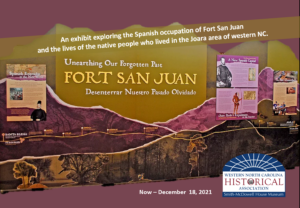This exhibit was developed as part of the celebration of the 450th anniversary of the Juan Pardo expeditions. Several decades ago, archaeologists identified a site near Morganton as the location of Joara, one of the largest Native American towns in what is today Western North Carolina. Joara was occupied from approximately 1400-1600 A.D. Two Spanish expeditions (led respectively by Hernando de Soto and Juan Pardo) visited the town in the 1500s. The Pardo expedition was part of a larger effort to establish a string of forts from the coast of present-day South Carolina to Mexico.
In 2013, archaeologists confirmed that Joara was also the site of Fort San Juan, established by Pardo in 1567, nearly 20 years before the English settlement at Roanoke on the coast of North Carolina and 40 years before the settlement at Jamestown. Through various artifacts uncovered by the archaeologists, the exhibit showcases the Spanish occupation of Fort San Juan and the lives of the native people who lived in the Joara area. The exhibit is on loan from the Exploring Joara Foundation Inc. Exploring Joara engages the public in archaeology in the Carolinas, and emphasizes the discovery of the Native American town of Joara and Fort San Juan.

